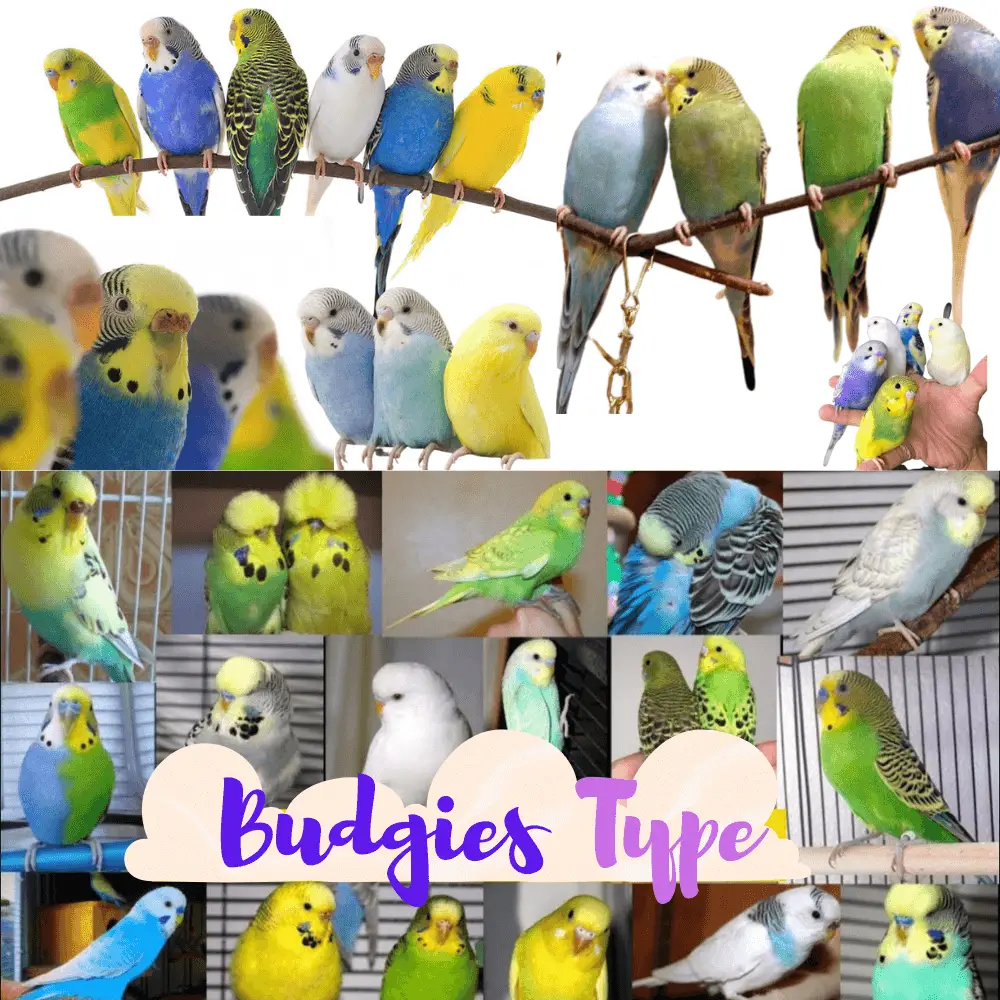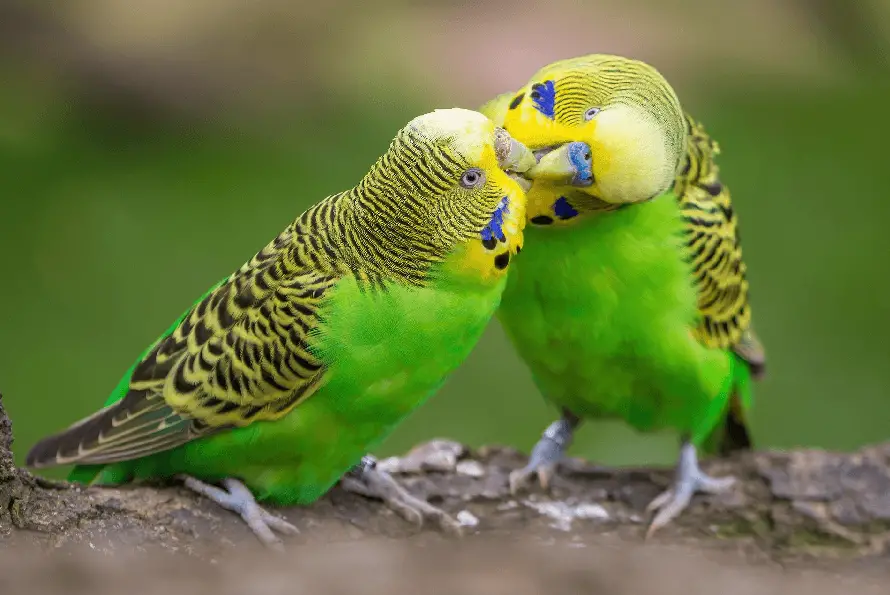
Budgies type: All Types of Budgie Colors, Varieties & Mutations.Varieties of wavy parakeets A random colored spot does not give a variety! To receive this qualification, the particular feather pattern, or the color of the marks, must be decided by genes and must be able to be passed on to the next generation.
The marks of budgies differ from the green/yellow standard and the blue/white types are divided into two broad categories: opaline and pearl.
41 Types of budgies
SOURCE:SMA Birds Aviary
Opaline Budgie
This is the most common variant. Wavy parakeets belonging to this mutation have fewer ripples on their head, shoulders, and back than standard birds if any. The general body color is also present on the wing feathers of birds of opaline mutation (a normal green/yellow bird has black and yellow wings, but in opalines, these are black and green, or a blue/white bird normally has black and white wings, but with this variant, these will be blue and white). Opaline parakeets tend to have a more pastel hue.

Beaded Budgie
The pattern of the wings and spots on the throat of these birds are very characteristic. Most wavy parakeets have black wings at the ends of their underlying body color (yellow or white), but in pearl mutation parakeets, these colors are reversed: yellow wings with black edges, for example. They also have fewer spots on the throat than standard birds, sometimes none at all. The ones they sport usually look like tiny targets, with a white dot in the center. Parakeets carrying two genes of the pearl mutation are mostly of a single dominant color, yellow or white, sometimes with some gradients of the other shades covering the plumage.
Beaded Budgie
The pattern of the wings and spots on the throat of these birds are very characteristic. Most wavy parakeets have black wings at the ends of their underlying body color (yellow or white), but in pearl mutation parakeets, these colors are reversed: yellow wings with black edges, for example. They also have fewer spots on the throat than standard birds, sometimes none at all. The ones they sport usually look like tiny targets, with a white dot in the center. Parakeets carrying two genes of the pearl mutation are mostly of a single dominant color, yellow or white, sometimes with some gradients of the other shades covering the plumage.
A pearl Budgie

Parakeets’ yellow mask and Australian golden mask
Yellow masks further complicate the distinction between blue and white and young/green. There are birds of the blue type with yellow masks, rather than white. Under the uninspired name Yellow Mask I, yellow is limited to the face, the edges of the wings, and the tail, descending a little more on the blue chest, making it slightly green.
Yellow Mask is a brighter yellow, where yellow is spread over more surface of the body that gives the parakeet a turquoise color, with some areas having kept their original blue. Such birds, however, retain blue ear spots.
Australian golden-mask parakeets have bright yellow faces and lots of yellow and green that still make them “blue” birds.
Light penne Budgie
These come in two different types: Texas and Easley (or Serrate). They are either white or yellow, with black undulations on the wings, but pale grey primary feathers. They also have shades of color, relative to their ancestry (green, blue or gray). Texas has more color on the body and purple ear spots, while the Easley has a much more divided color into two tones and silvery-gray ear spots.
English Budgie
The English parakeet is recognized worldwide. This is the most common type of show parakeet, which is why they are sometimes called “show parakeets”. Much larger than their wild cousins, their head feathers, bushier, make them look fuller and sometimes swell to such an extent that they completely conceal the bird’s beak. They can also sometimes have additional spots on the throat.
English parakeets are generally docile, and rather easy to tame and handle. They seem to seek human contact more than their wilder alter egos and will never use their beaks aggressively. This comes from the selective breeding that led to the creation of this competition bird. Indeed, wild, panicked, or aggressive specimens are not likely to impress the judges.
English or competition parakeets come in many colors
If you’ve only owned English parakeets, you probably won’t have noticed, but they’re much quieter than smaller types. They have a less piercing voice, have fewer “screaming fits” and are calmer, unlike smaller parakeets that spend their time chirping and chattering.
Types of crested Budgie
The excessive growth of feathers on the head is one of the characteristic features of “English” parakeets reproduced for competitions. Some varieties have tufts and hoopoes that completely conceal their faces, sometimes creating a strange “flower head” effect. However, unlike some animals (such as dogs, for example), even the largest, most feathered and fluffiest parakeets do not suffer from any health problems or discomfort as a direct result of this extravagant appearance (unless the mutation results from a known syndrome, such as poor “feather budger” parakeets with puny wings and plumage growing continuously and in all directions).
Hoopoes are not only limited to English parakeets. Like other genetic mutations, this is a natural occurrence that also appears in domestic farms. Hoopoes are formed by a group of feathers that grow the wrong way and curl outwards, like an explosion of hair in battle, instead of growing properly and close to the body.
There are three basic shapes for budgie hoopoes: straight, semicircular, or circular. The right hoopoe gives the parakeet an air of cockaticoat, while the circular hoopoes look more like a random perm.
The same mutation can cause feathers to grow haphazardly on other parts of the budgie’s body and in some extreme cases, it looks like fallen feathers that would have been glued back to the budgie anyhow. We are talking in all cases about crested wavy parakeets.
Crested Budgie
Rare Budgie Colors From time to time, a potential new variety of wavy parakeets emerges from the genetic background. The most recent is the Blackface mutation, a dark-colored bird with a mask “loaded” with black ripples covering the entire head and more, like a zebra reincarnated as a bird. The latter appeared in the Netherlands in the 1990s, before disappearing again following the decimation of all specimens due to disease (one of the dangers of isolating a new variety in the aviaries of a single breeder); There is no doubt that the mutation will reappear one day and the Blackface parakeet will return among us, perhaps with a more inspired name this time!
Another rarity that occurs briefly from time to time is the Browning mutation, a member of “brown parakeets” whose spots are brown on a normal-colored body.
These two varieties have not yet managed to establish themselves as new types or varieties in their own right, but are examples of the diversity and resistance of the gene pool of wavy parakeets. Even if they have disappeared, for now, they will probably reappear at some point.
Other rarities include the “Faded”, a mutation with slightly gray plumage as mentioned in the section on gray parakeets, but the gray effect is a little different.
Anthracite parakeets have dark gray bodies and ear spots, with usual black designs on the wings as well as long black rectrices, as if someone had used a monochrome filter on normal plumage. The mutation that creates this form is very rare and the current variety appeared in Germany in the 90s. Some experts believe that an extinct early twentieth-century variety, English gray, was genetically identical to anthracite.
The Saddleback mutation looks like the opaline parakeet at first glance (see above). However, the markings on the bird’s head are gray, not black, and the ripples are less marked between the base of the wings, looking more like spots of color. The usually black markings on the wings are also grey and become darker along the wing. Saddleback parakeets also differ from opaline parakeets by the lack of an inverted color effect.



















